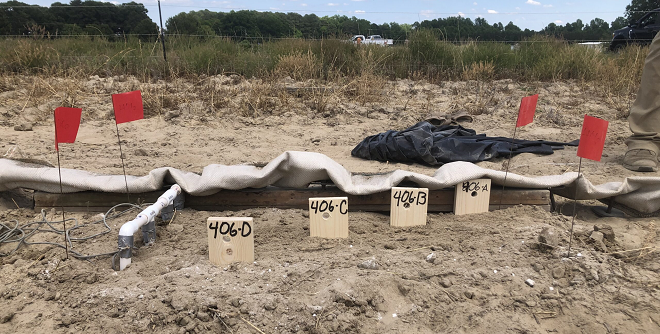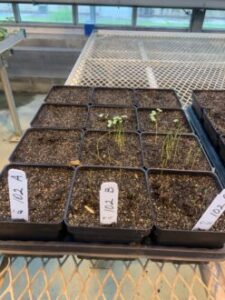

May 25, 2023Steam, chemicals offer weed and pathogen control options
Researchers are examining how growers can control weeds and soilborne pathogens through steam and alternative chemicals.
A session during the March 7-10 North American Strawberry Symposium in San Luis Obispo, California, examined research into weed and pathogen control through applying steam with quicklime, also known as calcium oxide and burnt lime, and sodium peroxide.
The study, by Emma Volk, a research assistant in the North Carolina State University Horticultural Science Department, probed how steam in combination with exothermic chemicals — chemicals that release heat in reaction with water — can allow soils to reach higher maximum soil temperatures and also possess longer lasting thermal effects.


Steam and the chemicals will control pythium species populations and weeds more than when the components are used alone. Pythium is a pathogen responsible for black fruit rot and other fungi. Other soilborne strawberry diseases include verticillium wilt and charcoal rot. Major weeds include nutsedge, which can poke through plastic and grow through the planting holes, prickly sida and annual rye grass.
One of Volk’s goals is to expand grower pest control options and lessen reliance on chemicals. Previous research studied steam as a soil disinfectant long used in greenhouse production systems.
The method is effective as a stationary application method, but recent research is examining mobile field steam applications, Volk said.
Steaming away
Steam, however, is material-, time- and water-intensive and is expensive. Volk wanted to see how researchers could make steam applications more efficient.
In North Carolina, growers typically begin fumigation during the fall, ahead of the state’s April to June strawberry season. For two seasons, Volk conducted a microplot study at NC State’s Clayton, North Carolina, research station.
Researchers applied six treatments in one by half-meter randomized plots in Norfolk sandy loam soil.
The treatments were 30-minute applications of steam alone, steam plus quicklime and steam plus sodium peroxide, plus individual applications of quicklime and sodium peroxide with only room temperature water.
Researchers sampled soils and inserted weed seed probes. To discover how far treatments would be effective from applicators, distances of 0.9, 4.7, 9.8 and 14.9 inches were examined.
In pathogen control, Volk found quicklime plus steam was the only treatment able to lower pathogen levels significantly compared to the non-treated control. Steam plus quicklime brings high average soil temperatures compared to steam plus sodium peroxide and steam by itself, Volk said.
“The treatment effect we saw on pathogen levels was that quicklime plus steam controlled for pythium species more effectively than the components by themselves,” Volk said. “However, we did not see this effect when we looked at the combination of sodium peroxide and steam. It did not control pythium species more effectively than steam on its own.”
Ending pathogens
Researchers found that regardless of treatment, pathogen levels tend to decrease as average temperatures increase. Pathogens were controlled once 131°F or 140°F temperatures were reached. An average temperature of 133°F for 30 minutes effectively controlled pythiums species, Volk said.
In weed control, a relationship between temperature and weed germination was observed, particularly for nutsedge tubers. Steam plus sodium peroxide and steam plus quicklime effectively controlled germination.
“As average temperature increases, that average percent of germination decreases,” Volk said. “There seems to be this point that once you exceed a certain temperature, the percent of germination reaches zero.”
In Volk’s research, that averaged 158°F. The study also found that high soil pH can significantly affect microorganism populations. As pH increases, microorganism populations decrease, but the process takes a long time, Volk said.
Overall, quicklime does better than sodium peroxide in improving field steam application efficiency.
“Quicklime is more promising because it has more positive effects on both pathogen levels and weeds in comparison to sodium peroxide, which primarily was just able to control for weeds,” Volk said.
Quicklime was found to maintain high temperatures at farther distances from steam injection compared to other treatments, Volk said.
As a proof-of-concept study, Volk said more work needs to be done before recommending to growers.
Volk’s research was sponsored by the North American Strawberry Growers Association, the Methyl Bromide Transition Program, the North Carolina Strawberry Association and the Southern Region Small Fruit Consortium.
— Doug Ohlemeier, assistant editor
Top photo: In a microplot study, NCSU researchers studied how growers can control weeds and soilborne pathogens through steam and alternative chemicals. Photos courtesy North Carolina State University.
Second photo: Studying soil temperature and pathogen levels during steam treatment, NCSU researchers found pathogen levels tend to decrease as average temperatures increase.














